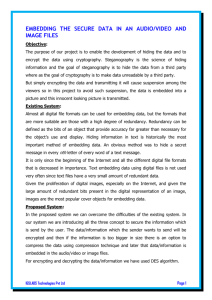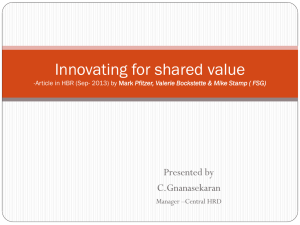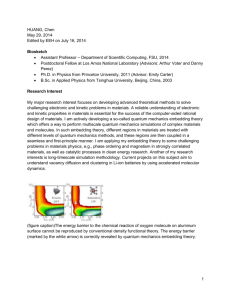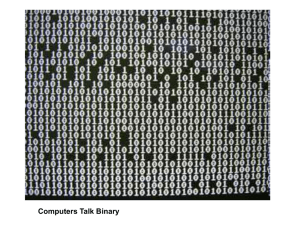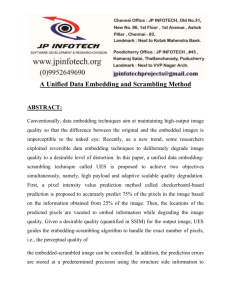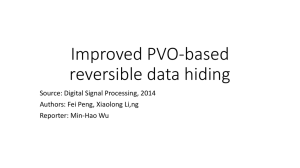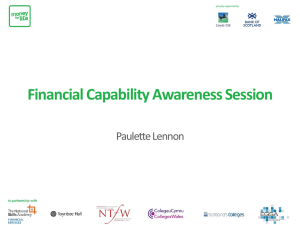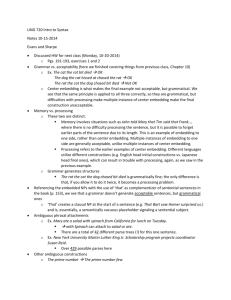Robust-method-of-information-hiding-using-transform
advertisement
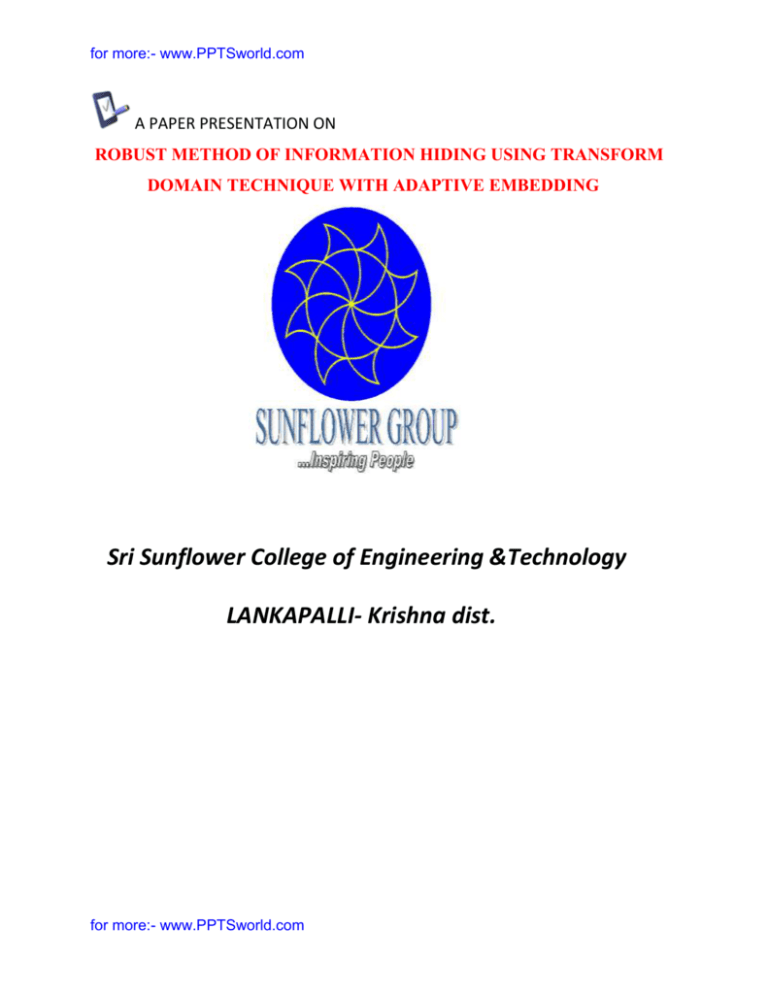
for more:- www.PPTSworld.com A PAPER PRESENTATION ON ROBUST METHOD OF INFORMATION HIDING USING TRANSFORM DOMAIN TECHNIQUE WITH ADAPTIVE EMBEDDING Sri Sunflower College of Engineering &Technology LANKAPALLI- Krishna dist. for more:- www.PPTSworld.com for more:- www.PPTSworld.com ABSTRACT There exist a wide range of protocols for hiding message in images. However, without leaving any apparent evidence of image alteration, security and robustness will be the key attributes of any particular technique. Many attacks to security constitute a first step towards performing attacks to robustness. In this paper, we demonstrate an algorithm to make the data embedding process as robust as possible. Starting form proper selection of images, blocks within the image and coefficients within the block this algorithm gives an idea of making the embedding process robust. Experimental results show an improvement as we follow this algorithm. 1. INTRODUCTION Digital communication has become an integral part of infrastructure now a day. Lot of applications are Internet based and in some cases it is desired that the Communication be made secret. Two techniques are available to achieve this goal: first is cryptography, where the sender uses an encryption key to scramble the message, this scrambled message is transmitted through the insecure public channel, and the reconstruction of the original, unencrypted message is possible only if the receiver has the appropriate decryption key. Second method is Steganography, where the secret message is embedded in an image. Using this technology even the fact that a secret is being transmitted has to be secret . Steganography is the art and science of communicating in a way, which hides the existence of the communication. Steganography or Stego as it is often referred to in the IT community, literally means, "covert writing" which is derived from the Greek language. In a digital world, Steganography and Cryptography are both intended to protect information from unwanted parties. Both Steganography and Cryptography are excellent means by which to accomplish this but neither technology alone is perfect and both can be broken. It is for this reason that most experts would suggest using both to add multiple layers of security . The algorithm demonstrated in this paper will give an idea of selection of proper image for embedding the information as well as making the data hiding process more robust. 2. REQUIREMENTS OF STEGANO GRAPHIC DATA HIDING There are three requirements depending for the purpose of Steganography data hiding: a) Capacity (Pay Load): It is an important factor when a lot of information is to be embedded into a cover image. for more:- www.PPTSworld.com for more:- www.PPTSworld.com For example the personal data and the diagnosis could be embedded into medical images. Another example could be embedding personal information into finger print image. b) Imperceptibility: It is important when a secret communication occurs between two parties and the fact of a secret communication is kept to be secret. For example information exchange required for credit card transactions. c) Robustness: Watermarking, fingerprinting and all copyright protecting applications demand robust steganographic method, i.e. where the embedded information cannot be removed without serious degradation of the image 3. SELECTION OF IMAGE FOR DATA HIDING When we consider digital image as a cover (image in which data is to be embedded), it is important that the Stego-image (image along with hidden information) does not contain any easily detectable attributes due to message embedding. A third party could use such attributes as an indication that a secret message is present. Once this message detection can be reliably achieved, the steganographic tool becomes useless. Obviously, the less information is embedded into the cover-image, the smaller the probability of introducing detectable attributes by the embedding process. Another important factor is the choice of the Cover image. The selection is at the discretion of the sender who Sends the message. The sender should avoid using Cover images that would be easy to analyze for presence n obtained with a digital camera contain a high number of colors and are usually recommended and considered safe for Steganography. Some Steganography experts recommend grayscale images as the best cover-images . There are essentially three types of image formats: raw, uncompressed formats (BMP, PCX), palette formats (GIF), and lossy compressed formats (JPEG, Wavelet). Only few current steganographic programs offer the capability to embed messages directly in the JPEG stream. It is a difficult problem to devise a steganographic method that would hide messages in the JPEG stream in a secure manner while keeping the capacity practical. Far more programs use the BMP or GIF format. The GIF format is a difficult environment for secure Steganography with reasonable capacity. Also, most steganographic techniques for GIFs implemented in current software products prioritize capacity over security and are thus relatively easy to detect . The raw formats, such as BMP, offer the highest capacity and best overall security. for more:- www.PPTSworld.com for more:- www.PPTSworld.com 4. EMBEDDING TECHNIQUES The steganographic algorithms can be divided into two groups: Spatial/Time domain and Transform domain techniques. Least Significant Bits (LSB) modification techniques are easy way to embed information but they are highly vulnerable to even small cover modifications. An attacker can apply signal processing techniques to destroy the embedded information. Compression of images may create problems and there may be total loss of information. The transform domain methods operate in the Discrete Cosine Transform (DCT), Fourier Transform (FT) or Wavelet Transform (WT) domains of the host signal. Transform domain cover modification has advantages over spatial domain cover modification. It is robust to attacks such as compression, cropping and some image processing attacks and it is imperceptible to human sensory system therefore more undetectable. Data embedding is done in the Transform domain, with a set of transform coefficients in the low and mid frequency bands selected as possible candidates for embedding (these are preserved better under compression attacks than high frequency coefficients). Most of the embedding methods require side information about the hiding locations to be sent to the decoder, which reduces the size of the payload. In contrast, the method prescribed in this paper uses property of an image block for selection of that block for embedding the information. The use of local criteria for deciding where to embed is found to be crucial for maintaining image quality under high volume embedding. The decoder does not have explicit knowledge of the locations where data is hidden, but employs the same criteria as the encoder to guess these locations. The distortion due to attacks may now lead to insertion errors. There may be synchronization problem between encoder and decoder, which has to be properly handled by proper coding of text and error correcting mechanisms. 5. EMBEDDING ALGORITHM A. Text Information processing: 1. Read a text file from which information is to be embedded. 2. Encode the text information. 3. Add redundancy for error correction into the encoded information. 4. Make a series of bits information (BI) ready for embedding. B. Image Processing: for more:- www.PPTSworld.com for more:- www.PPTSworld.com 6. Divide image into 8 x 8 blocks. 7. Take DCT2 of each block. 8. Calculate Entropy of each block. 9. Calculate Mean Value of Entropy (MVE) of all blocks. 10. Check number of blocks having Entropy greater than MVE and treat them as Valid Blocks (VB). 11. Divide the DCT2 coefficients by Quantization Matrix (QM) 12. Find the Valid (non zero) Coefficients (VC) in each VB by reading them in zigzag manner. 13. If the total number of VC are less than number of BI then image is not suitable for embedding the information. 14. Embed BI in VC of all VB in zigzag order (except DC component). Range of coefficients in middle frequency may be chosen. 15. Multiply all quantized coefficients by QM. 16. Take IDCT2 of all blocks. 17. Reconstruct the image as Stego-image. 18. Write / Transmit image. Now let us see the processing of embedding in detail. 6. TRANSFORM DOMAIN While transforming domain, first cover image is divided into 8 x 8 blocks. These blocks are then converted to Discrete Cosine Transform (DCT2) coefficient blocks using Discrete Cosine Transform. Two-dimensional DCT of an M-by-N matrix A is defined as follows. The resultant 8 x 8 matrix of DCT2 coefficients and the way in which it is scanned from coefficient_0 to Coefficient_63 and read while embedding the information is as shown in Fig. 1. Here coefficient_0 is called as DC coefficient. Frequency variations in horizontal and vertical direction are as shown in Fig. 2. Fig. 3 shows categorization of DCT2 coefficients as low frequency (FL), middle frequency (FM) and high frequency (FH). for more:- www.PPTSworld.com for more:- www.PPTSworld.com In our experimentation we used middle frequency coefficients (FM) for information hiding so that the information is stored in a significant part of the image. In order to make the algorithm robust against JPEG compression, the DCT2 coefficients chosen for embedding the information must be selected cleverly. Figure 1. Zigzag Scan of DCT2 Coefficients Figure 2. Frequency Variation in DCT2 Figure 3. Middle Frequency Coefficients Level Entropy Thresholding (ET) is the method used for deciding whether or not to embed data in each block depending on the entropy, or energy, block can be selected for embedding the information . It is important to note that the DC (i = j = 1) coefficient is neither used for Entropy calculation nor for information embedding. This is because JPEG uses predictive coding for the DC coefficients and hence, any embedding induced distortion would not be limited a single 8 x 8 block. The blocks whose energy is greater than a predefined threshold are selected for information embedding. Process of ET is as shown in Fig.4, Fig.5 and Fig.6 for the images, ‘ flower’, ‘Finger’ and ‘bliss’ respectively. Figure 4. Image ‘flower.bmp’ and Entropy Thresholding Figure 5. Image ‘finger.bmp’ and Entropy Thresholding for more:- www.PPTSworld.com for more:- www.PPTSworld.com Figure 6. Image ‘bliss.bmp’ and Entropy Thresholding Table 1 Image ME VB MSE PSNR Bliss 8330 1357 3.9064 10-2 62.21 Flower 34073 1784 5.2183 10-2 60.95 finger 125216 3274 9.5725 10-2 58.32 In our experiment we tried to embed 800 characters in each of these typical images, ’flower’, ‘finger’ and ‘bliss’ respectively. Table 1 shows our experimental result. It gives comparison of three typical images with respect to MVE, number of VB for embedding, MSE and Peak Signal to Noise Ratio (PSNR). Image ‘bliss’ is having very low variations of pixel values, therefore having minimum ME as well as less number of VB. On the other hand, image ‘finger’ is having very high variations of pixel values and therefore maximum ME as well as more number of VB. Table 1 clearly shows that image ‘finger’ is best suitable candidate for hiding information for the same value of data hiding capacity. The graphs of block entropy of all the blocks for all three images are as shown in Fig. 4, Fig. 5 and Fig. 6 for images, ’flower’, ‘ finger’ and ‘bliss’ respectively. Our further experimentation is on an image ‘finger’. As we increase the value of ET the number of valid blocks of embedding are reducing with increase in PSNR. The results shown in Fig. 7. and Fig. 8. gives an idea about effect of increase in threshold value of number of valid blocks and PSNR. In order to increase PSNR one should increase the value of ET. However, it reduces the valid blocks and in tern pay load or embedding capacity. Wider band of quantized middle frequency coefficients in valid block and keeping the close eye on PSNR is the solution to increase the pay load. Figure 7. Number of valid blocks image Finger Figure 8. PSNR for image ‘finger’. for more:- www.PPTSworld.com for more:- www.PPTSworld.com Pay load result shown in Fig. 9. gives an idea about selection of proper image for embedding . As image ‘bliss’ gives drastic decrease in pay load as we increase ET from 0.2 MVE to 2.0 MVE, hence not suitable for heavy pay load applications. Figure 9. Effect of ET Variation on VC 7. QUANTIZATION MATRIX Although in this paper we explain the technique on grayscale images, it can be extended to color images in a straightforward manner. We start with a short description of the JPEG compression algorithm. In JPEG compression, the image is first divided into disjoint blocks of 8×8 pixels. For each block (with integer pixel values in the range 0-255), DCT2 is calculated, producing 64 DCT coefficients. Let us denote the i-th DCT coefficient of the k-th block as dk (i), 0 = i = 64, k = 1, … T, where T is the total number of blocks in the image. In each block, all 64 coefficients are further quantized to integers Dq(i) using the JPEG quantization matrix Q as shown . 8. EMBEDDING THE INFORMATION For embedding the information we are selecting the blocks having entropy higher than the MVE for all blocks of the image. Within the block we are selecting the quantized coefficients having non-zero values, and are within the middle frequency range, excluding DC component and few low frequency components. For hiding data we are quantizing the values of the coefficients with the smallest possible value, so that image has less possible perceptual and statistical degradation (less MSE). However, at the same time we have to make sure that the change persists through the reverse process, which is essential for error free extraction of the embedded information 9. INVERSE TRANSFORM DOMAIN The DCT is an invertible transform, and its inverse IDCTis given by 10. CONSTRUCTION OF STEGO IMAGE After the process of embedding, all the coefficients are multiplied with the quantization matrix. Take the inverse DCT of the block. The blocks, which are not used for embedding, are taken as it is in Stego image. At the end all the blocks are organized to get image, which is our stego image. 12. LIMITATIONS for more:- www.PPTSworld.com for more:- www.PPTSworld.com Embedding in DCT domain is simply done by altering the DCT coefficients, for example by changing the least significant bit of each coefficient. One of the constraints of embedding in DCT domain is that many of the 64 coefficients are equal to zero, and changing two many zeros to non-zeros values will have an effect on the compression rate. That is why the number of bit one could embed in DCT domain, is less that the number of bits one could embed by the LSB method. Also the embedding capacity becomes dependent on the image type used in the case of DCT embedding, since depending on the texture of image the number of non-zero DCT coefficients will vary. Although changing the DCT coefficients will cause unnoticeable visual artifices, they do cause detectable statistical changes. 13. ATTACKS It is important to note the difference between the oncepts of robustness and security. Attacks to robustness are those whose target is to increase the probability of error of the datahiding channel Attacks to security are those aimed at gaining knowledge about the secrets of the system (e.g. the embedding and/or detection keys) Many attacks to security constitute a first step towards performing attacks to robustness. Security does not imply robustness at all. A Steganography scheme can be extremely secure, in the sense that it is (almost) impossible for an attacker to estimate the secret key(s), but this does not necessarily affect the robustness of the system. For instance, random selection of block for embedding the information using secret key highly improve the security of the system, but they do not improve in any way the robustness of the method. LSB insertion is an easy way and provides a high capacity to embed data into images, but it does not provide protection against small changes resulting from lossy compression or image transformations. An attacker may intentionally perform a JPEG compression to fool the receiver because he knows that, under a certain JPEG quality factor, the hidden message may effectively be disturbed. In this case an attacker can disturb the message but cannot learn anything about the secret of the system. As we are using JPEG quantization matrix for qualifying the coefficient for embedding the information the possibility of corrupting the information gets drastically reduced. However, as level of compression increases, the number of valid coefficients gets reduced which in tern reduces the pay load. 14. CONCLUSION for more:- www.PPTSworld.com for more:- www.PPTSworld.com 1. Entropy thresholding gives better perceptual quality of image and system becomes more secured as it avoid suspicious view of the attacker. 2. Instead of fixed DCT2 coefficient the image adaptive selection of blocks and coefficients will increase the security. Even the decoder does not have explicit knowledge of the locations where data is hidden, but employs the same criteria (shared with the decoder) as the encoder to guess these locations. 3. Encryption of message before embedding gives additional security. 4. Added redundancy in information bits gives error free recovery of hidden data at the receiver. 5. Quantization matrix plays an important role in increasing the robustness and reducing the pay load. for more:- www.PPTSworld.com
